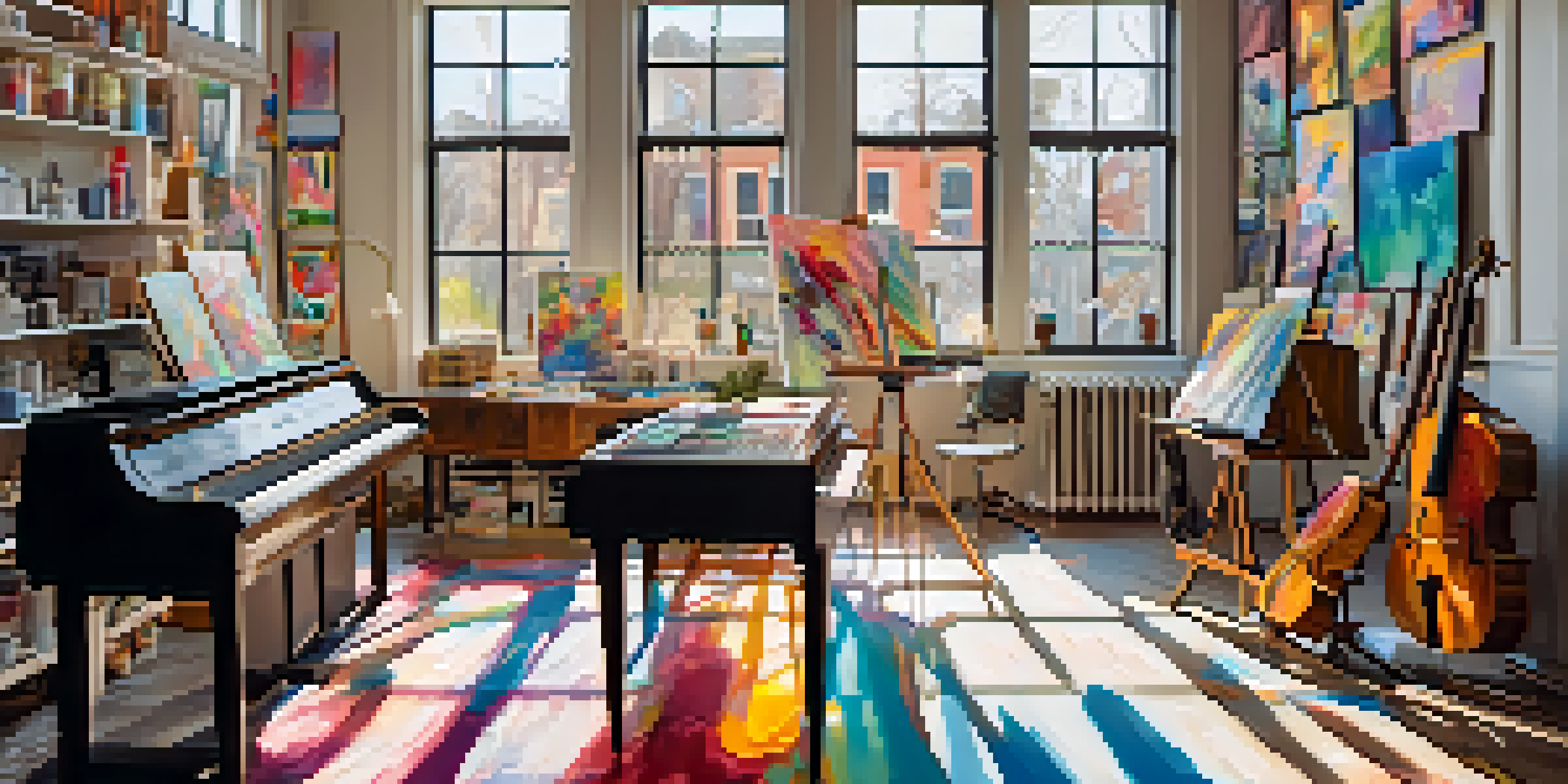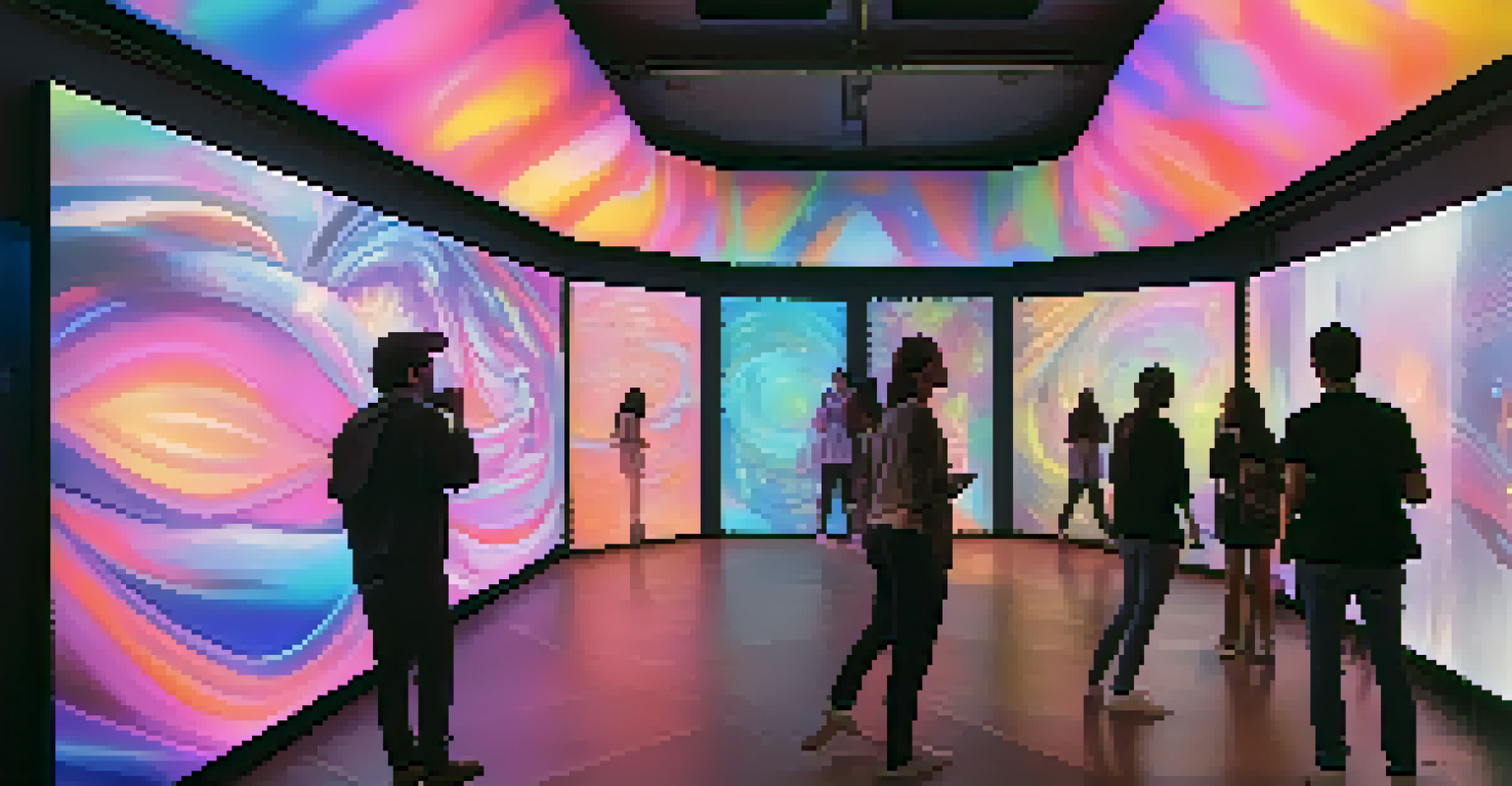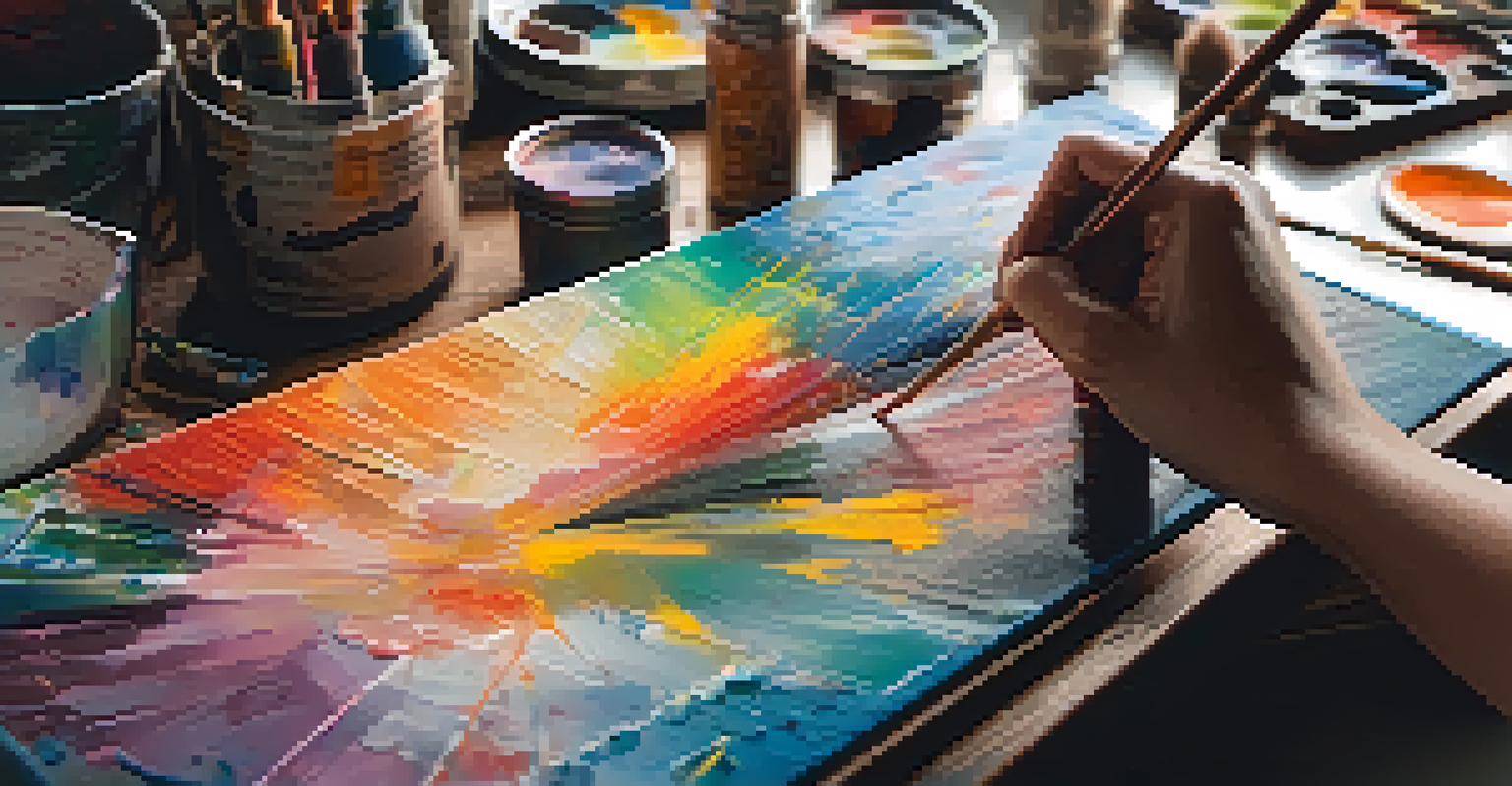Artistic Expression: Music as a Muse for Visual Artists

The Symphony of Senses: Music's Role in Art Creation
Music has an incredible ability to evoke emotions, creating a rich atmosphere that can influence visual artists. Many painters, sculptors, and digital creators find that listening to their favorite tunes sparks inspiration and enhances their creative flow. Just like a painter chooses colors, artists select music to set the mood for their work, transforming their environment into a symphony of creativity.
Music is the shorthand of emotion.
When artists immerse themselves in melodies, they often enter a state of 'flow'—that magical moment when time seems to disappear, and creativity flourishes. For instance, renowned painter Wassily Kandinsky was known for his love of music, believing that colors and sounds could be intertwined to express emotions. This alignment of auditory and visual elements allows artists to explore new dimensions in their work.
Ultimately, the relationship between music and visual art is a dance of inspiration, where each form influences the other. As artists draw from the energy and emotions of music, they create pieces that resonate with viewers on multiple levels, inviting them to experience the artwork in a more profound way.
Different Genres: How Styles of Music Inspire Unique Art
Just as different musical genres evoke varying emotions, they can also inspire distinct styles of visual art. For example, the vibrant chaos of jazz may lead to spontaneous, abstract paintings filled with energy, while classical music might inspire more structured and serene compositions. Each genre serves as a muse, guiding artists to explore different themes and techniques in their work.

Take the world of hip-hop, for instance, where artists often incorporate bold colors and dynamic imagery to capture the essence of the lyrics and beats. Street art, which is heavily influenced by hip-hop culture, showcases how music can manifest in visual forms that speak to social issues and personal narratives. This genre's raw energy and storytelling elements encourage artists to push boundaries and create impactful visual statements.
Music Sparks Artistic Inspiration
Visual artists often find that music enhances their creative flow and evokes emotions that influence their work.
In contrast, the calm and reflective tones of ambient music might inspire minimalistic art, where simplicity and subtlety reign. This genre invites artists to focus on negative space and the delicate interplay of light and shadow, creating a peaceful visual experience. By understanding how various musical styles influence artistic expression, we can appreciate the diverse outcomes in the visual arts.
Collaboration: Musicians and Visual Artists Unite
Collaboration between musicians and visual artists often leads to innovative creations that transcend traditional boundaries. For instance, album cover art has become a vital part of music marketing, with artists like Andy Warhol famously designing iconic covers for The Velvet Underground. This partnership allows both art forms to enrich one another, creating a multisensory experience for audiences.
Art is the most beautiful of all lies.
Live performances also demonstrate this beautiful collaboration, with visual artists creating stunning visuals that accompany musicians. Think of concerts where projections dance across the stage, enhancing the music and engaging the audience on multiple levels. This synergy fosters a unique atmosphere where the audience can experience the art of sound and sight simultaneously, leaving a lasting impression.
Moreover, collaborative projects often challenge both musicians and visual artists to step outside their comfort zones. By sharing their creative processes, these artists can inspire each other and explore new perspectives, leading to groundbreaking works that redefine their respective fields.
Emotional Resonance: Music's Impact on Artistic Themes
Music has a profound ability to elicit emotions, and this emotional resonance often shapes the themes that visual artists explore in their work. An artist may listen to a heartbreaking ballad and be inspired to create a poignant piece that reflects feelings of loss and longing. This connection allows viewers to engage with the artwork on a deeper emotional level, as they resonate with the themes conveyed through both music and art.
Consider how the stirring compositions of composers like Beethoven can evoke deep reflections on the human experience. Artists inspired by such music may explore themes of struggle, triumph, and beauty, translating those complex emotions into visual narratives. The result is a rich tapestry of feelings that draws viewers in, inviting them to ponder the shared human experience.
Genres Shape Artistic Styles
Different musical genres inspire distinct styles of visual art, with each genre serving as a muse for various themes and techniques.
In this way, music serves as a catalyst for artistic exploration, allowing artists to convey their emotions and experiences through their chosen medium. By embracing the emotional depth of music, visual artists can create works that speak to the heart, forging connections that transcend the boundaries of language and culture.
Art Movements: Historical Influence of Music on Visual Art
Throughout history, various art movements have been influenced by the sounds and rhythms of their time. For example, the Futurist movement celebrated modernity and dynamism, often drawing inspiration from the sounds of machinery and urban life. Artists like Umberto Boccioni created works that reflected the energy and speed of their era, intertwining visual art with the musical pulse of the time.
Similarly, the Dada movement emerged as a reaction to World War I, characterized by its absurdity and spontaneity. Artists in this movement often embraced chance and randomness, much like avant-garde musicians who defied traditional structures. This convergence of visual art and music demonstrated how historical contexts could shape artistic expression and give rise to new ideas.
By examining these movements, we can see how music has played a pivotal role in shaping the course of visual art history. Each era's unique soundscape has inspired artists to respond to their environment, resulting in innovative forms of expression that continue to resonate today.
The Personal Connection: Artists' Favorite Tunes
Every artist has their own personal playlist that fuels their creativity, often including tracks that hold special meaning. For many, music becomes an essential part of their creative routine, helping to set the stage for their artistic process. Whether it's a soothing classical piece or an upbeat pop hit, these tunes stir emotions that influence the artist's work.
For instance, some artists might find that listening to instrumental music helps them focus, allowing their thoughts to flow freely onto the canvas. Others may be inspired by lyrics that resonate with their experiences or dreams, prompting them to translate those feelings into visual narratives. This intimate connection between music and personal expression adds layers of depth to the artwork.
Collaboration Transcends Boundaries
The collaboration between musicians and visual artists leads to innovative creations that enrich both art forms and create multisensory experiences.
Ultimately, the music that artists choose to surround themselves with reflects their individuality and creative journey. By sharing these personal soundtracks, artists invite their audience to understand the influences behind their work, creating a richer appreciation for the final piece.
The Future: Music and Visual Art in the Digital Age
As we venture further into the digital age, the interplay between music and visual art continues to evolve. New technologies and platforms allow artists to experiment with interactive forms of expression, where viewers can engage with both sound and sight in innovative ways. Virtual reality (VR) and augmented reality (AR) are at the forefront of this transformation, offering immersive experiences that combine music and visual art.
For instance, artists can create virtual galleries where visitors can walk through environments that respond to the music they hear. This fusion of mediums breaks traditional boundaries, inviting audiences to experience art as a multi-sensory journey. As technology progresses, the possibilities for collaboration between musicians and visual artists are limitless.

Looking ahead, we can expect even more dynamic partnerships and projects that challenge our perceptions of art. As both fields continue to adapt and grow, the relationship between music and visual art will undoubtedly inspire new generations of artists to explore uncharted territories, shaping the future of creative expression.